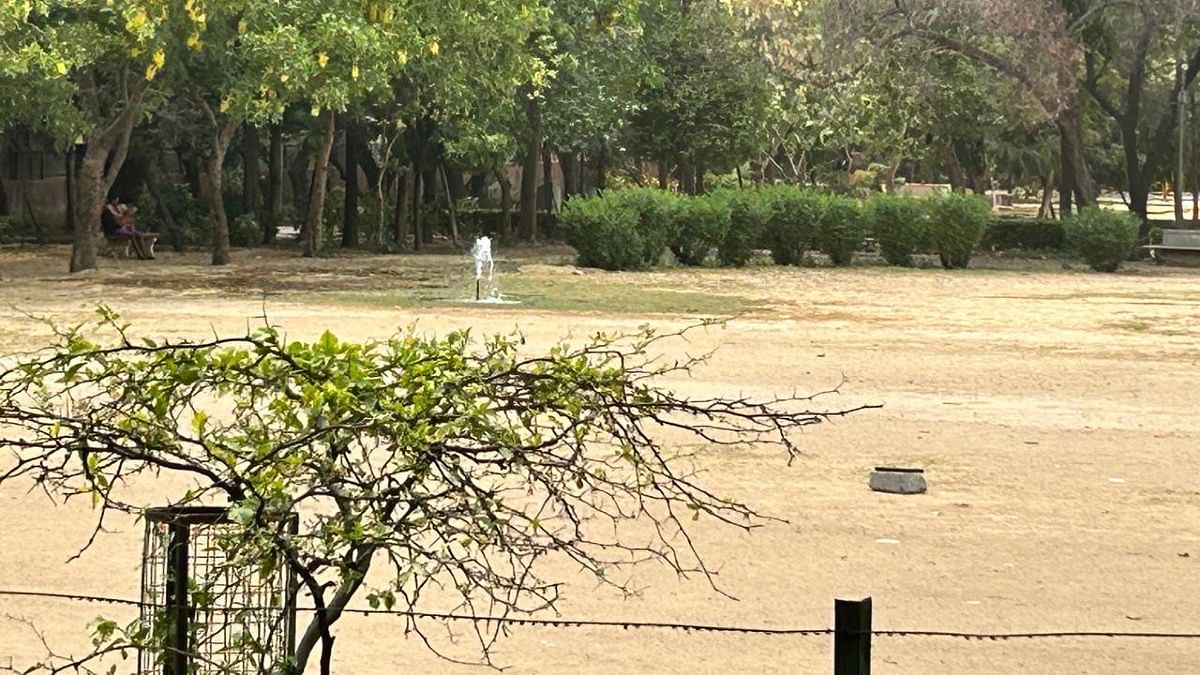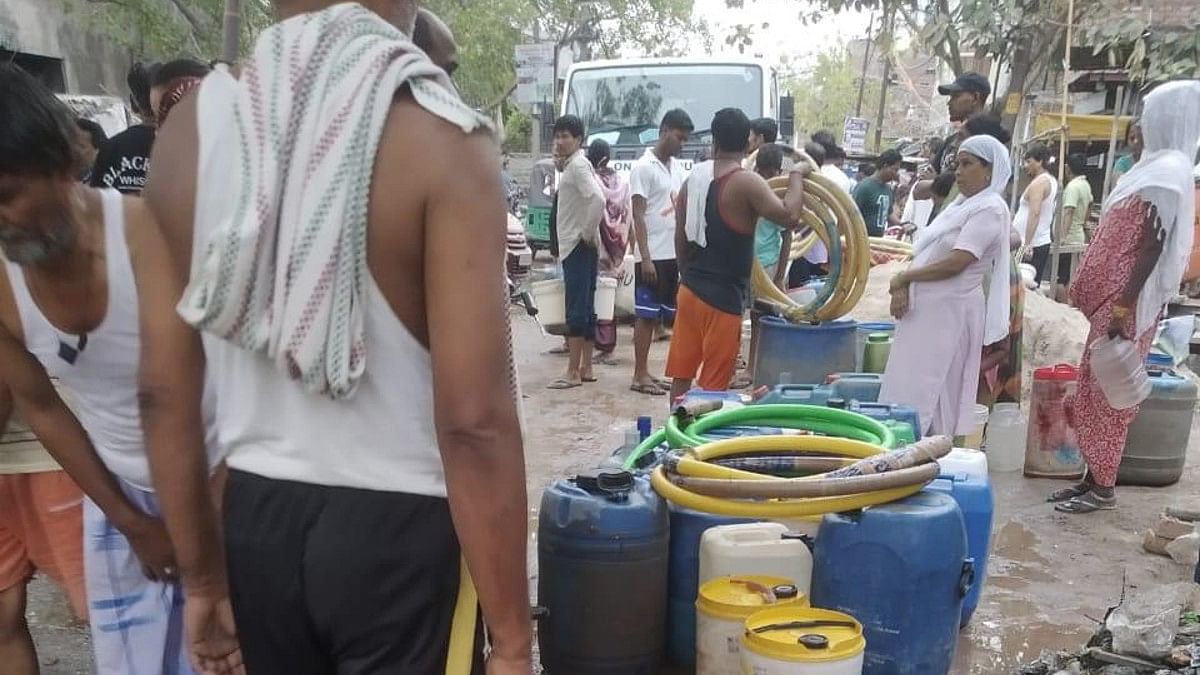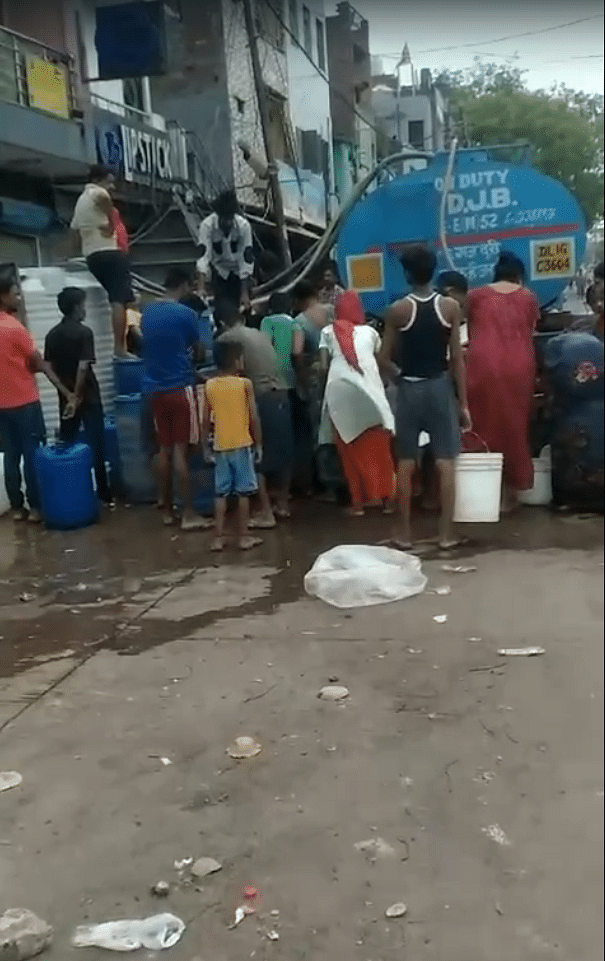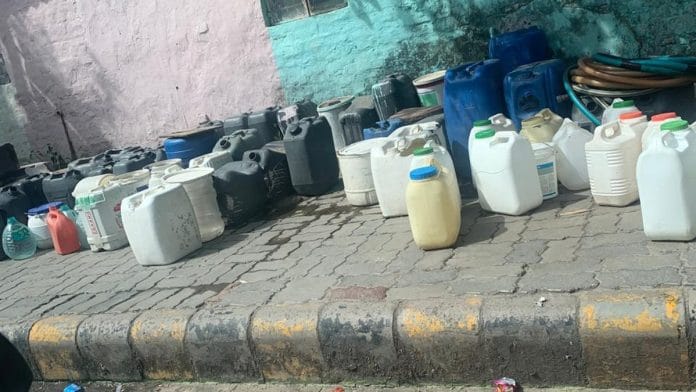New Delhi: Buckets or utensils in hand, residents, mostly women, stood in queue, sometimes for hours at end, for their turn at the borewell in a park half a km from Jamrudpur village in the heart of South Delhi. As temperatures soared to record highs, many had to do this at least two or three times each day to clinch their share of water — around 40 litres.
The village is located on a steep elevation that gradually goes higher as one travels further into Jamrudpur with its narrow lanes and improper drainage system. When ThePrint visited in mid-June, the mostly single-room houses here had not seen a stable supply of water for two weeks straight. In the case of some, it had been three months.
Rains have since brought respite from the heat, but the water crisis accentuated class divides and reaffirmed the political nature of abundance and scarcity.
It also demonstrated that while water sources may not change, population density and share of water supply do undergo changes.

The Capital’s water distribution network spans approximately 15,383 km of pipelines, with a significant portion outdated and prone to leaks.
An accountant living in Deepawali Enclave, Pooja said she faced severe water shortage for most of June. Though located close to a water treatment plant on the Delhi-Haryana border, the family had to install an additional pipe to their private borewell connection. “The situation has never been like this, let alone this bad, the past two weeks we haven’t been receiving water.”
Similarly, Sudhir, an electrical contractor living in Sangam Vihar said he was paying for private tankers of water, with no guarantee of quality. The water bore a pungent smell, but the family had to use it for household purposes, while relying on ‘Bisleri tankers’ for drinking water.
Rinku, a painter for an architecture firm in East of Kailash and resident of Okhla Industrial Area, said he hadn’t been particularly affected. His ‘normal’ comprised receiving water every alternate day for a few hours and things hadn’t gotten better or worse.
Women from the Vivekanand Camp near Chanakyapuri, interestingly, said contrary to viral visuals, the water crisis in their locality was not as stark as it seemed. Water tankers rolled in at fixed hours thrice a day. “I have no idea why the media are fixated on the issue of water when our public latrines are not being maintained, when our drains remain clogged,” said one.
The contrast, however, does little to diminish the fact that Delhi has been recognized as a water-scarce region as per the Master Plan of Delhi of 2041.
Also Read: Delhi’s tanker mafia begins from Jal Board borewells—pipes, profits, politics
How Delhi gets its water
As provided by the framework of the Economic Survey of Delhi 2022-23, there are three main sources of water to the Capital.
The first is in the form of raw water from Haryana through carrier line channels, Delhi sub-branch canals, and the Yamuna, culminating in a total of 1,133 cusecs (612.5 million gallons per day).
The second is the Ganga water supply. The Ganga Canal/Murad Nagar Regulator supplies 470 cusecs (254.08 MGD) for Bhagirathi and Sonia Vihar water treatment plants.
The third is groundwater supply, 117 MGD through Ranney wells and tube wells in the Yamuna floodplains and other areas in Delhi.
The New Delhi Municipal Council (NDMC), Delhi Cantonment Board and Municipal Corporation of Delhi (MCD) are the main bodies responsible for distribution of water.

In areas governed by NDMC and Delhi Cantonment, Delhi Jal Board (DJB) supplies bulk water, with NDMC and Delhi Cantonment responsible for its distribution. The Jal Board also provides water through tanker services for areas outside its jurisdiction.
According to the DJB, 93 percent of the households in the Capital have access to piped water, though the quantity and quality is subject to variation.
Delhi has a network of 15,383 km of pipelines and over 117 underground reservoirs (UGR) to supply water to approximately 20 million people.
From water tanks to motors
For Rajiv Kakria, member of Greater Kailash RWA and convener of ‘Save Our City Campaign’, the words ‘dispute’ and ‘scarcity’ when talking of water first came up in the 1970s and 80s.
Residents then depended on the Aastha Kunj tank (a huge overhead tank) for water supply, he explained. Slopes and natural gradients were used to get the water to a particular point and a single motor was used to pump the water; once it was full, the supply was directed to the settlement located downstream.
The tank, said Kakria, was only connected to the bathroom system or for the geyser. Fresh water (taaza pani) was used for household activities and for drinking purposes, not the water from the tank. Most people didn’t keep tanks since it was seen as a luxury for additional supply.
By the 1990s, the motor started gaining currency. There was also a compulsion felt by residents living on first or second floors to maintain underground tanks for storage of water. “I made one myself in 2002, an underground tank with a storage capacity of 6,000 litres,” said Kakria.
This shift to motors was some years after the removal of the Aastha Kunj tank and it came at a cost. According to Kakria, motor usage constitutes nearly 25 percent of Delhi’s power consumption. This, he termed a “national waste”.
Kakria emphasised that the “faulty pipe system” was at the heart of the water crisis in parts of the Capital, adding that seepage and pilferage of treated water pollutes the groundwater and in turn “our blood streams, not making us any healthier”.
Water losses are calculated by subtracting billed or consumed water from total production, referred to as non-revenue water (NRW).
NRW accounts for 58 percent of Delhi’s total water supply, significantly higher than the global standard of 10–20 percent observed in most developed nations. This figure encompasses unbilled water supplied to JJ clusters and unauthorised colonies.
Politics of water & the way ahead
Asked about steps taken by the Delhi Government to tackle the water crisis, Aam Aadmi Party (AAP) MLA Somnath Bharti made clear that the challenges were mainly by way of politics, between states and parties. “This is a BJP-manufactured crisis.”
The statement followed acknowledgment of the fact that Delhi gets its water from various external sources through Uttar Pradesh and Haryana, and of late, it had been receiving “100 MGD less water on average, which had a considerable impact on 29 lakh people”.
The AAP government devised the Palla Floodplain Project in 2019, to address recurring flooding in Delhi, aiming to harness excess river water that would otherwise flow into the Yamuna. As of 2023, the 26-acre pond successfully recharged 740 million gallons of groundwater.
Bharti, meanwhile, also spoke about the ‘Toilet-to-Tap’ initiative with the first sewage treatment plant being set up in Keshopur that he said filtered around 5,000 litres of sewage to give an output of 4,000 litres of potable water per hour.
Delhi’s strategy for water augmentation involves both increasing groundwater and surface water resources, besides initiatives like wastewater treatment and reuse, rainwater harvesting, and restoration of water bodies.
By 2041, Delhi aims to add 584 MGD to its water supply, projecting a total availability of 1,519 MGD to serve an estimated 30 million residents.

To sum up, a one-size-fits-all approach, as has been the modus operandi of government officials and civic bodies, is unsustainable. The need of the hour is regularly spaced area-specific inspections of pipeline systems and measures to ensure that while extraction is reduced, there are also measures to address flooding and increase in groundwater levels.
As Kakria said, “Sustainability after all is not the means of boycotting what is being used but rather minimising and altering utility to make a difference.”
Manavi Sharma is an intern with ThePrint
Also Read: ‘Court can appoint independent committee on water supply and usage in Delhi,’ Delhi govt tells SC






